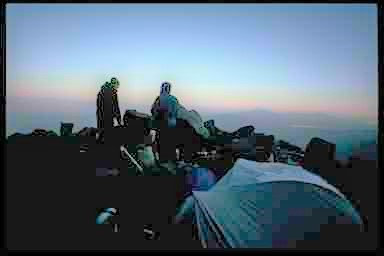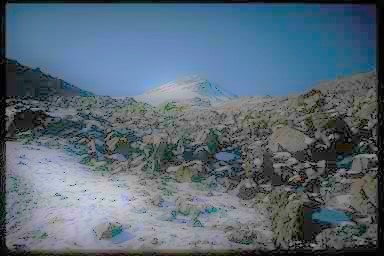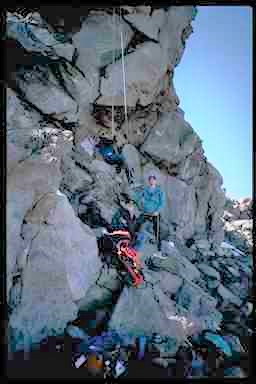


Back to Chronological List of Trips
Back to Home Page
I went to a mountaineering seminar on Mt. Shasta, California which ran from September 10 to September 17. Since it was a short trip, this will be a short trip report.
The 7 days of the trip can be broken down into 4 groups: 2 days traveling to and from Mt. Shasta City, 2 days backpacking to and from our base camp, 2 days mountaineering training and 1 day going to the summit. The travel and backpacking days were fairly normal and won't receive further mention.
Although I have done mountaineering trips before, I decided that if I were going to do more of them, I should really receive some actual training. Many of the things we were trained on I already knew or had done to some degree. However I feel much more confident now that I've been through a full training course.
The first day covered crampons and how to use them on snow. (Crampons are the spiked devices you attach to your boots.) After walking around on a snow field getting used to crampons we took them off and started practicing self-arrest.
Self-arrest is the way to stop yourself if you start sliding on ice or snow. The standard techniques depend on you having an ice ax which we all did. The first technique practiced is starting from a seated position. You start yourself sliding, roll over, plant your ice ax and bring yourself to a stop. We practiced this over and over. We got a little damp sliding and rolling around in the snow. Our knees also got quite sore since you're digging them in as well as your ice ax.
Once we were nearly automatic at the seated self-arrest, we moved on to the head-first self-arrest. You lie on your stomach, head downhill, start sliding and again get yourself stopped. Then we moved on to the tough one, on your back, headfirst. After working on these guys, the first one, seated, looked like a real piece of cake.
The second day of training started with more practice with crampons. We then moved on to crevasse rescue with prussic loops. If you're roped up while crossing a glacier and fall into a crevasse, prussic loops are equipment which you can use to get yourself out. Of course this assumes there are others on your rope who didn't get pulled in.
We didn't really get into a crevasse. Our guides climbed to the top of a rock and hung a rope down. We took turns hooking our loops into this rope and climbing up 8 or 10 feet. I don't like dangling from ropes. However this wasn't as bad as I thought. Of course in addition to the rope we were going up, there was also a belay rope in case there were any problems with the climbing rope.
Setting up the belay and climbing ropes and giving everyone a chance to prussic up took the better part of the training time. However it was time well spent. It was fun, interesting and an important technique to know when crossing glaciers.
After two days of training, we were ready to attempt the summit. We got up about 3am, got our gear ready and had a little breakfast. We were on our way at 4:15am. This was different from other summits I've done. We alternated between hiking and climbing on rocks and using our crampons on snow and ice. Usually you hike up to the snow, put on your crampons and hike up snow or ice the rest of the way.
Some people were having a little trouble with crampons on the ice. We'd practiced on snow but the ice was a new wrinkle. We were not making good time that way. We moved faster when we got over on the rocks and followed them up. However, normally snow and ice travel is faster than rocks. The rock climbing was frustrating because every 3 steps there was another mini-problem to resolve. The problems were figuring out handholds and foot placements to get up small sections.
Going up there were 3 rope teams. I was in the middle team. At one point the first team had real trouble getting up a section. It was a slightly new route for our leader and it didn't work out as well as hoped. The first team eventually made it up this section. My team was half way up. We turned around and went down the part we'd gotten up. The lower team took a different route from the point we returned to.
On getting down this section our team decided we'd had enough. I was getting very tired. One of the others was getting very uncomfortable being on the mountain and was ready to head back. Since it was about 1:30 or 1:45 pm and the turn-around time was 2pm, it all added up to a reasonable decision to continue on down.
I finally got back to camp about 8:45pm. We'd been on the go for 16.5 hours. 6 of 10 of us had made the summit, 8 of 13 if you count the guides.
Although other summits I've done have been colder, higher or steeper, this was clearly the most difficult and technical of any of the summits I've attempted. While getting to the summit is always a goal and not getting to it is disappointing, I'm comfortable with my efforts this day.
I accomplished 90-95% of my objectives on this trip. The remaining 5-10% was getting to the summit. Not a bad score. The next time I attempt any mountaineering I'll be a lot more comfortable with my abilities. However, I don't have any immediate mountains in mind. Mountain Travel's 1995 catalog won't be coming out for another month or so. I'll read it over and decide what I'll be doing next year.


